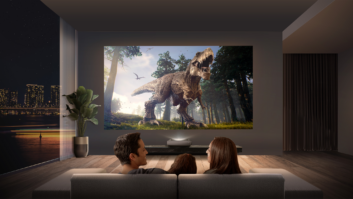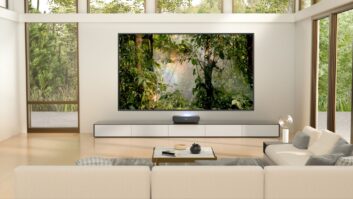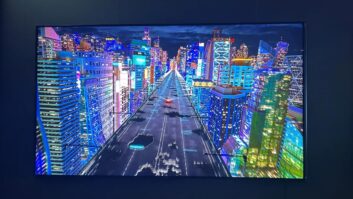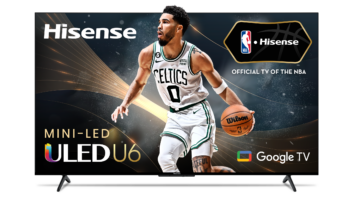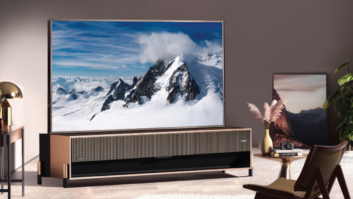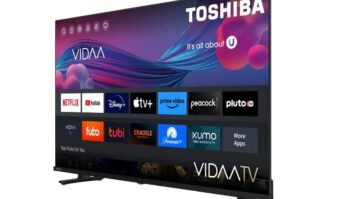SUWANEE, GA. – One year into its three-year branded marketing strategy for the U.S., Hisense has made significant strides toward its goal of becoming a dominant CE brand here, the company’s international marketing director told TWICE.
JoAnne Foist, who Hisense selected as its first westerner to handle international marketing of the Hisense brand, said the company in the last 12 months has elevated its product breadth in the U.S. with the addition of midtier TVs to complement low-end models, while preparing to add source devices and major appliances to the product portfolio.
For this first year, Hisense USA is on track to achieving a $306 million brand sales goal for TVs (up from $94 million last year), with plans for significant brand sales growth each year.
“We plan to be a solid tier-two player going into 2013 and a tier-one player after five years,” Foist said. “We plan to do this by offering state-of-the art products that customers are demanding at the best value.”
The tack is not dissimilar to the path employed by brands like Vizio and Westinghouse Digital, but Foist said Hisense adds the distinction of being a powerful product manufacturer and designer of its own products.
Foist said Hisense USA recently has moved to a new larger corporate campus here, consisting of a 36,000-square-foot facility that houses sales and marketing, after-sales service, and a comprehensive hightech R&D and engineering center.
The company also has been building its distribution, making the Hisense brand available through more national, regional and online e-tailers.
Retail distribution, Foist said, is targeted at the warehouse clubs, mass merchants, regional TV/appliance chains, e-retail and rent-to-own channels.
So far, the Hisense TV brand is carried by Walmart, Walmart.com, hhgregg and Costco.com, with others coming on board soon, she said.
New product introductions under the Hisense badge include a full range of LCD TVs from basic to high-end LED backlit models that include smart-TV and 3D functionality.
For the future, Hisense is working on N-Screen, 4K glasses-free 3D and transparent LCD TV, all of which it showed at International CES 2012. In addition the company is engaged in collaborative OLED research and development and will be market ready “when the technology meets the customer value proposition.”
Hisense also has an extensive smart-TV strategy planned, with Cloud services hosted at an internal datacenter, in addition tapping into localized Cloud services hosted by third-party providers, Foist said.
The manufacturer is even engaged in developing second-screen applications and experiences by leveraging its cellphone business.
“In the U.S. we plan to launch the IPTV in 2013 with support for Android and iOS mobile devices,” Foist said. “Hisense-branded mobile devices will follow.” Brand building has started to take on more urgent status as Hisense reaches for the next level.
Foist said Hisense was founded in China in 1969 and has risen to become the fifth largest TV brand in the world (currently No. 1 in its domestic China market).
Hisense has an annual production output surpassing 16 million televisions, 20 million appliances and 8 million mobile phones from 19 factories around the world.
The company recently launched a completely new consumer website at Hisense-USA.com to assist in both sales and support of Hisense-branded gear, Foist said.
“Now customers can find answers to their questions online without having to contact our service team,” said Foist. “And if customers still need to contact our service team, they can fill out an online form that goes directly to our customer support team.”
The company will also begin a stepped-up public relations campaign in coming weeks to “get the word out” through the media about “the new” Hisense brand.
“We plan to connect with consumers on an emotional level to establish a relationship,” said Foist. “We want to be seen as the ideal choice in electronics.”
Thus far, Foist said Hisense has used a “push strategy” focused on the retailer to gain distribution points using customized selling presentations to drive traffic and sales.
Consumer advertising has been carried out through retail partners as the distribution base went broader.
Hisense has long been known as a major OEM of private-label products, with products carried by retailers under the Hitachi (Sears) and Insignia and Dynex (Best Buy) house brands.
But the company now sees the importance of expanding the visibility of its own brand, as a marketer of products it manufactures.
“We differentiate from our OEM in the amount of product features we offer,” Foist explained. “The Hisense- branded TVs are developed based on our extensive R&D work and market studies. Our OEM is based on the requirements of the company for whom we are building the products. They are still of very high quality, but they are built to the OEM spec instead of from our branded target market spec.”
Foist said the company has sold both OEM and Hisense-brand products through the same retail accounts in some cases, “because the products meet different market demands and customer segments.”
The branded Hisense TV line currently includes LCD TVs ranging in screen size from 19 to 55 inches. This encompasses LED back and edge-lit models ranging in screen size from 19 to 71 inches, including Cinema-series models with ultra-wide 21:9 aspect ratios to better handle Cinemascope content without black bands on the screen.
Some Hisense TV technologies include 3D capability (either active shutter or passive film-pattern retarder based), smart TV/Android TV/connected TV systems, direct- and edge-lit LED TVs, and super slim/dual color injection, Foist said.
“Our philosophy with our retailers is `Same features, better price — Same price, better features,’ she continued. “So, our goal is to be the best value, not necessarily the lowest cost, in each product category.”
Top-of-the-line TVs in the T770 and T710 series use LED lighting and include smart-TV connectivity, 3D, and FullHD 1080p resolution. Also included is an ultra-narrow design (0.31- to 0.9-inch bezel widths).
Midtier products in the K560, K316, K366 and K312 series have also include LED, smart TV, 3D and 1080p with a bezel thickness of 0.7 to 1.1 inches, while entry LCD TVs in the K310, K20, K26, K360, V86 and V77 series include either LED or CCF rear lighting technologies.





